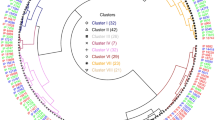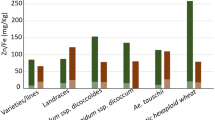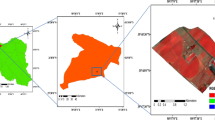Abstract
Assessing genetic variability of micronutrient content in association with qualitative and quantitative traits in germplasm is prerequisite for effective biofortification programme. Odisha, a state of eastern India is considered as one of the most potential hot spot of diversity of cultivated rice for grain yield and nutritional traits. Significant variability for most of the qualitative and quantitative traits including Fe and Zn content was observed in a set of 293 germplasm with varying kernel colour encompassing 14 districts of Odisha. Mostly these landraces were low yielding with some exception (Haldigundi: AC 36454, 50.08 g/plant). These landraces were mostly represented by medium Fe (10–20 ppm)—medium Zn group (20–30 ppm). Fe and Zn content had positive association with each other and also with grain size. Landraces with red kernel colour were observed to have slightly higher average Zn content (26.30 ppm) as compared to white (25.87 ppm) grains. Diversity analysis of 14 districts revealed that Nayagarh, a south-eastern district was rich in Fe content while Deogarh, Keonjhar and Mayurbhanj, all north-western districts were rich in Zn content. This study identified 10 superior micronutrient dense genotypes with medium to high Fe and Zn content. This set of donors for micronutrient content was validated in another year. Champeisiali (AC 43368) and Gedemalati (AC 34306) with highest Fe (44.1 ppm) and Zn (40.48 ppm) content, respectively were detected over the environments. Identified donors and associated traits could be utilized in biofortificaion programme using appropriate breeding methodologies for enhancing micronutrients in high yielding background.












Similar content being viewed by others
Availability of data and materials
We declared that materials and raw data described in the manuscript will be available to any scientist wishing to use them for non-commercial purposes, without breaching participant confidentiality.
Abbreviations
- CP:
-
Coleoptile colour
- BLS:
-
Basal leaf sheath colour
- LP:
-
Leaf pubescence
- STC:
-
Stigma colour
- LIS:
-
Ligule shape
- PAN:
-
Panicle type
- APC:
-
Apiculus colour
- LSEN:
-
Leaf senescence
- THR:
-
Threshability
- KC:
-
Kernel colour
- LB:
-
Leaf blade colour
- AUC:
-
Auricle colour
- AWN:
-
Awning
- PANE:
-
Panicle exertion
- FLA:
-
Flag leaf angle
- G:
-
Green
- P:
-
Purple
- Pli:
-
Purple line
- INT:
-
Intermediate
- PUB:
-
Pubescence
- W:
-
White
- CLE:
-
Cleft
- ST:
-
Straw
- RAP:
-
Red apex
- SL:
-
Slow
- R:
-
Red
- ME:
-
Moderate exerted
- S:
-
Liguleshape
- PH:
-
Plant height
- LL:
-
Leaf length
- LW:
-
Leaf width
- ET:
-
Effective tiller
- DFFL:
-
Days to 50% flowering
- PL:
-
Panicle length
- HGW:
-
Hundred grain weight
- Fert:
-
Fertility percentage
- Fe:
-
Iron
- Zn:
-
Zinc
- GL:
-
Grain length
- GB:
-
Grain Breadth
- L/B:
-
Length breadth ratio
- Y:
-
Yield
- PCV:
-
Phenotypic coefficient of variation
- GCV:
-
Genotypic coefficient of variation
- ECV:
-
Environmental coefficient of variation
- BSH:
-
Broad sense heritability
- GA:
-
Genetic advance
References
Amarasinghe YPJ, Kuwata R, Nishimura A (2020) Evaluation of domestication loci associated with awnlessness in cultivated rice (Oryza sativa). Rice 13:26
Amegan E, Efisue A, Akoroda M, Shittu A, Tonegnikes F (2020) Genetic Diversity of Korean Rice (Oryza Sativa L.) germplasm for yield and yield related traits for adoption in rice farming system in Nigeria. Genomics 8:19–28
Anuradha K, Agarwal S, Batchu AK, Babu AP, Swamy BM, Longvah T, Sarla N (2012) Evaluating rice germplasm for iron and zinc concentration in brown rice and seed dimensions. J Phytol 4:19–25
Banerjee S, Chandel G (2011) Understanding the role of metal homeostasis related candidate genes in Fe/Zn uptake, transport and redistribution in rice using semi-quantitative RT-PCR. J Plant Mol Biol Biotechnol 2:33–46
Banu H, Jagadeesh BN (2014) Genetic analysis of skewness and kurtosis for yield and its parameters, total grain protein, macro and micro nutrients in F7 generation of rice (Oryza Sativa L.). Environ Ecol 32:381–385
Bollinedi H, Yadav AK, Vinod KK, Gopala KS, Bhowmick PK, Nagarajan M (2020) Genome-wide association study reveals novel marker trait associations governing the localization of Fe and Zn in the rice grain. Front Genet 11:213
Bouis HE, Welch RM (2010) Biofortification-A sustainable agricultural strategy for reducing micronutrient malnutrition in the global south. Crop Sci 50:20–32
Brar B, Jain S, Singh R, Jain RK (2011) Genetic diversity for iron and zinc contents in a collection of 220 rice (Oryza sativa L.) genotypes. Indian J Genet 71:67–73
Briat J, Rouached H, Tissot N, Gaymard F, Dubos C (2015) Integration of P, S, Fe and Zn nutrition signals in Arabidopsis thaliana: potential involvement of PHOSPHATE STARVATION RESPONSE 1 (PHR1). Front Plant Sci 6:290. https://doi.org/10.3389/fpls.2015.00290
Chandel G, Banerjee S, See S, Meena R, Sharma DJ, Verulkar SB (2010) Effects of different nitrogen fertilizer levels and native soil properties on rice grain Fe, Zn and protein contents. Rice Sci 17:213–227
Chandel G, Samuel P, Dubey M, Meena R (2011) In silico expression analysis of QTL specific candidate genes for grain micronutrient (Fe/Zn) content using ESTs and MPSS signature analysis in rice (Oryza sativa L.). J Plant Genet Trans 2:11–22
Chattopadhyay K, Sharma SG, Bagchi TB, Molla KA, Sarkar S, Marndi BC, Sarkar A, Dash SK, Singh ON (2018) Development of recombinant high yielding lines with improved protein content in rice (Oryza sativa L.). J Agric Sci. https://doi.org/10.1017/S0021859618000230
Das SR (2012) Rice in Odisha. IRRI Technical Bulletin No. 16. International Rice Research Institute 31, Los Baños
Dikshit N, Sivaraj N, Sultan SM, Datta M (2016) Diversity analysis of grain characteristics and micronutrient content in rice landraces of Tripura, India. Bangladesh J Bot 45:1143–1149
Gande NK, Kundur PJ, Soman R, Ambati R, Ashwathanarayana R, Bekele BD, Shashidhar HE (2014) Identification of putative candidate gene markers for grain zinc content using recombinant inbred lines (RIL) population of IRRI38 × Jeerigesanna. Afr J Biotechnol 13:657–663
Gangashetty P, Salimath PM, Hanamaratti NG (2013) Association analysis in genetically diverse non-basmati local aromatic genotypes of rice (Oryza sativa L.). Mol Plant Breed 4:31–37
Gour L, Maurya SB, Koutu GK, Singh SK, Shukla SS, Mishra DK (2017) Characterization of rice (Oryza sativa L.) genotypes using principal component analysis including scree plot & rotated component matrix. Int J Chem Stud 5:975–983
Gregorio GB (2002) Progress in breeding for trace minerals in staple crops. J Nutr 132:500–502
Gregorio GB, Senadhira D, Htut H, Graham RD (2000) Breeding for trace mineral density in rice. Food Nutr Bull 21:382–386
Islam MZ, Khalequzzaman M, Bashar MK, Ivy NA, Mian MAK, Pittendrigh BR, Haque MM, Ali MP (2018) Variability assessment of aromatic rice germplasm by pheno-genomic traits and population structure analysis. Sci Rep 8:9911
Kohli S, Mohapatra T, Das SR, Singh AK, Tandon V, Sharma RP (2004) Composite genetic structure of rice land races revealed by STMS markers. Curr Sci 86:850–854
Maganti S, Swaminathan R, Parida A (2020) Variation in iron and zinc content in traditional rice genotypes. Agric Res 9:316–328
Mishra A, Das D, Saren S, Dey P (2016) GPS and GIS based soil fertility maps of Nayagarh district, Odisha. Ann Plant Soil Res 18:23–28
Mishra A, Kumar P, Shamim M, Tiwari KK, Fatima P, Srivastava D, Singh R, Yadav P (2019) Genetic diversity and population structure analysis of Asian and African aromatic rice (Oryza sativa L.) genotypes. J Genet 98:92
Mishra A, Nanda SK (2008) Soils of Deogarh District. Orissa Rev, 44–46
Neeraja C, Sarla N, Siddiq E (2002) RAPD analysis of genetic diversity in Indian land races of rice (Oryza sativa L.). J Plant Bio Chem Biotechnol 11:93–97
Norton GJ, Deacon CM, Xiong L, Huang S, Meharg AA, Price AH (2010) Genetic mapping of the rice ionome in leaves and grain: identification of QTLs for 17elements including arsenic cadmium iron and selenium. Plant Soil 329:139–153
Paltridge N, Palmer L, Milham P, Stangoulis J (2012) Energy-dispersive x-ray fluorescence analysis of zinc and iron concentration in rice and pearl millet grain. Plant Soil 361:251–260
Panda D, Sahu N, Behera PK, Lenka K (2020) Genetic variability of panicle architecture in indigenous rice landraces of Koraput region of Eastern Ghats of India for crop improvement. Physiol Mol Biol Plants 26:1961–1971
Pusadee T, Jamjod S, Chiang YC, Rerkasem B, Schaal BA (2009) Genetic structure and isolation by distance in a landrace of Thai rice. Proc Nat Acad Sci USA 106:13880–13885
Rao LVS, Shoba Rani N, Chiranjeevi M, Chaitanya U, Sudharshan I, Suneetha K, Jyothi B, Choudhary DR (2013) DUS Characterization of rice varieties. Directorate of Rice Research, Hyderabad
Rao SP, Madhubabu P, Kota S, Bhadana VP, Varaprasad GS, Surekha K, Neerja CN, Babu VR (2014) Assessment of iron and zinc variability in rice germplasm using energy dispersive X-ray florescence spectrophotometer (ED-XRF). J Rice Res 7:45–52
Rawte S, Saxena RR (2018) Morphological characterization of selected rice (Oryza sativa L.) from core germplasm group of Chhattisgarh using DUS descriptors. Int J Curr Microbiol Appl Sci 7:350–357
Raza Q, Riaz A, Saher H, Bibi A, Raza MA, Ali SS (2020) Grain Fe and Zn contents linked SSR markers based genetic diversity in rice. PLoS ONE 15(9):e0239739. https://doi.org/10.1371/journal.pone.0239739
Roy SC, Sharma BD (2014) Assessment of genetic diversity in rice (Oryza sativa L.) germplasm based on agro-morphology traits and zinc-iron content for crop improvement. Physiol Mol Biol Plants 20:209–224
Roy PS, Patnaik A, Rao GJN, Patnaik SSC, Chaudhury SS, Sharma SG (2016a) Participatory and molecular marker assisted pure line selection for refinement of three premium rice landraces of Koraput, India. Agro Ecol Sust Food Syst 41:167–185
Roy S, Marndi BC, Mawkhlieng B (2016b) Genetic diversity and structure in hill rice (Oryza sativa L.) landraces from the North-Eastern Himalayas of India. BMC Genet 17:107
Sahu GC, Mishra A (2005) Soil of Orissa and its management. Orissa Rev 16:56–60
Sakamoto T, Matsuoka M (2004) Generating high-yielding varieties by genetic manipulation of plant architecture. Curr Opin Biotechnol 15:144–147
Saleh AS, Wang P, Wang N, Yang L, Xiao Z (2019) Brown rice versus white rice: nutritional quality, potential health benefits, development of food products, and preservation technologies. Compre Rev Food Sci Food Safety 18:1070–1096
Shi Z, El-Obeid T, Li M, Xu X, Liu J (2019) Iron-related dietary pattern increases the risk of poor cognition. Nutr J 18:48
Stangoulis J, Sison C (2008) Crop sampling protocols for micronutrient analysis. Harvest Plus Tech Monogr Ser 7. International FOOD Policy Research Institute (IFPRI) and International Centre for Tropical Agriculture (CIAT), Washington DC, Cali
Swamy MBP, Rahman MA, Inabangan-Asilo M, Amparado A, Manito C, Mohanty C, Reinke R, Slamet-Loedin IH (2016) Advances in breeding for high grain Zn in rice. Rice 9:49–57
Tripathy SK (2020) Genetic variation for micronutrients and study of genetic diversity in diverse germplasm of rice. J Crop Weed 16:101–109
Vanlalsanga S, Singh P, Singh TY (2019) Rice of Northeast India harbor rich genetic diversity as measured by SSR markers and Zn/Fe content. BMC Genet 20:79
WHO (2011) Zinc for better health: The World Health Report. Switzerland, Geneva
Wynne JC, Gregory WC (1981) Peanut breeding. Adv Agron 34:39–71
Zhu C, Kobayashi K, Loladze I (2018) Carbon dioxide (CO2) levels this century will alter 1058 the protein, micronutrients, and vitamin content of rice grains with potential health 1059 consequences for the poorest rice-dependent countries. Sci Adv 4:eaaq1012
Acknowledgements
Authors are thankful to Director, ICAR-National Rice Research Institute, Cuttack, India and the ‘Harvest Plus programme: Biofortification in rice’, IFPRI, Rome for providing necessary funding and facilities for execution of this study.
Author information
Authors and Affiliations
Contributions
BCP provided the germplasm material. PS, KC, GP conducted field experiments, for micronutrient analysis, prepared the manuscript. LKB, TB, AK, KC conducted statistical analysis. NM, PS involved in graphical presentation of the data.
Corresponding author
Ethics declarations
Conflict of interest
None.
Ethical approval
This article did not include any experiments with human participants or animals performed by all the authors.
Consent for publication
The manuscript has been approved by all named authors.
Additional information
Publisher's Note
Springer Nature remains neutral with regard to jurisdictional claims in published maps and institutional affiliations.
Supplementary Information
Below is the link to the electronic supplementary material.
Rights and permissions
About this article
Cite this article
Sanghamitra, P., Bose, L.K., Bagchi, T.B. et al. Characterization and exploring genetic potential of landraces from Odisha with special emphasis on grain micronutrient content for benefaction of biofortification in rice. Physiol Mol Biol Plants 28, 203–221 (2022). https://doi.org/10.1007/s12298-021-01119-7
Received:
Revised:
Accepted:
Published:
Issue Date:
DOI: https://doi.org/10.1007/s12298-021-01119-7




